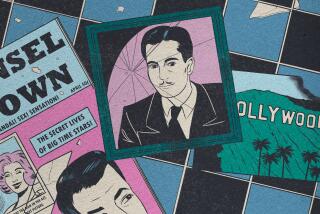Column: Instead of a pardon, how about giving Susan B. Anthony the Hollywood biopic she deserves?
- Share via
I learned about the suffragist movement from television.
This is very strange, considering that, as my colleague Lorraine Ali recently pointed out, the long, difficult, maddening, inspiring and often violent road to universal suffrage is a story that film and television do not like to tell. At all.
But when I was a child, “Masterpiece Theater” was a family ritual, which meant I saw “Upstairs, Downstairs” — the original — at a very young age. And the episode “A Special Mischief” is burned into my memory.
In it, Elizabeth Bellamy (Nicola Pagett), the daughter of Richard and Lady Marjorie Bellamy (David Langton and Rachel Gurney), joins a window-breaking suffrage demonstration, trailed by the devoted and disapproving parlormaid Rose (Jean Marsh). All the women are arrested but while Elizabeth gets off, Rose goes to jail. There, the other members of the group go on a hunger strike, which results in them being force-fed by some super grim-looking prison matrons. This being 1970s television, the procedure occurs offscreen but the grisly feeding tube gets a big closeup and the throat- and psyche-scouring after-effects are very clear.
Watching it years later, as an adult, I realized that the message is much more about class than gender equality — Elizabeth is a privileged dilettante, and the suffragists spend more time picking on Rose than talking about the need to vote. But as a kid, the force-feeding, and the subsequent explanation by my history-teacher father, impressed upon me how long, difficult and often brutal the fight for the vote had been.
And, as Lorraine wrote, it would be decades before I saw even a brief reference to that fight on television again.
The major milestones of feminist history, including ratification of 19th Amendment, are rarely seen on TV. But women’s lives, work and politics are vital to it.
This absence is, of course, part of a larger problem — as with history, the writing of film and television has long been controlled by white men and, in a very real way, defined by white-male-centric stories. Since the establishment of this country, white men were guaranteed the right to vote; the only suffrage battles they faced involved ensuring that the vote remained exclusive to them.
So maybe it’s not surprising that studio heads and development executives rarely if ever gave thought to the women’s suffrage movement, with its remarkable leaders and deep if complicated relationship with temperance, the abolition of slavery and education reform.
Hollywood has paid scant attention, until fairly recently, to the millions of women who have contributed in every area of human development. Even feminists refer to it all as “herstory,” as if all those centuries of women’s lives were merely a quaint counterpoint to history.
Consider, as an example, the Winston Churchill/Harriet Tubman ratio. Churchill struggled in the snake pit of British politics to hold the political line against the Nazis while keeping the nation unified with great oratory. Tubman struggled under and escaped from slavery and worked with abolitionists, many of whom also gave excellent, game-changing speeches while she made her way through actual snake pits, risking a return to slavery in order to lead hundreds of others to freedom.
I don’t want to argue about apples and oranges; I just want to point out that there are approximately 50 million films and TV shows celebrating the wonder of Winston Churchill, at least half of which were made by Americans, and about one each (the film “Harriet,” the series “Underground”) paying such homage to Tubman.
So is it really any surprise that the Schuyler sisters have, by way of the generally male-centric “Hamilton,” now seen way more stage and screen time than, say, Lucretia Mott and Lucy Stone or even Elizabeth Cady Stanton and Susan B. Anthony?
Anthony has just had her name ignominiously linked with President Trump, a man who stands for everything she fought against. Mr. President, Susan B. Anthony does not need you to pardon her.
Michelle Obama made just the right impassioned plea for Joe Biden during strange first night of convention
Why, in this time of period-piece renaissance, has no one thought to make a miniseries called “Seneca Falls,” even as a special-event commemoration of the 19th amendment’s centennial? Talk about a confluence of history. There is no bromance that could ever match the devoted, prickly and world-changing friendship between Stanton and Anthony, and the conflicts between the abolitionists and the women’s movement are very much tied to the contemporary alliances and tensions that exist in activism for race and gender equity today.
And where, may I ask, is the biopic about Sojourner Truth? She escaped enslavement with her infant daughter, successfully sued a white slave-owner for custody of her young son and delivered historically affecting oratory on abolition and women’s rights — including but far from limited to her famous “Ain’t I a Woman” speech at the Ohio Women’s Rights Convention in 1851.
Where is the series chronicling the life of Ida B. Wells? Freed from enslavement by the Emancipation Proclamation, she went on to become a journalist who, among other feats, called out Anthony’s racism and launched a crusade against segregation and lynching.
“Hidden Figures” dispelled any notion that filmgoers won’t embrace stories about women who’ve been excised from history; Alena Smith’s “Dickinson” and Greta Gerwig’s “Little Women” proved that notable women of the past resonate deeply with modern audiences; and “Mrs. America” cannot be the final word on the modern women’s movement. So, in addition to those women mentioned above, here is a brief list of standouts who also should make the cinematic cut before yet another white male gangster, politician, soldier, con man or cop.
What the Emmy-nominated miniseries gets wrong about feminism past and present.
Sacagawea: The ultimate example of doing what men do, only backward and in heels, Sacagawea was pregnant when she began her travels as an interpreter and guide for early 18th century explorers Lewis and Clark. She gave birth during the journey and often sat in the front of the boat with her infant son to communicate the peaceful nature of the enterprise. Along the way, she discovered the brother from whom she had been separated when she was kidnapped by another tribe as a child. At one point she saved all the provisions — and the famous journals — after the boat was swamped. So, drama galore.
Amelia Bloomer: The woman who introduced Elizabeth Cady Stanton to Susan B. Anthony also founded the first newspaper for women, the Lily. But she’s best known as an early proponent of pants for women. It was Stanton’s cousin, Libby Miller, who adopted loose-fitting trousers under skirts to allow herself more freedom of movement, but it was Bloomer who publicized the style (hence the term “bloomers”). The fight for female freedom through fashion is a long and important one and Bloomer was a big part of it, although she did give up in her later years. If we can lose our collective minds over the psychological connotations of “The Phantom Thread,” imagine the possibilities of examining fashion as an actual liberator.
Laura Ingalls Wilder: The “Little House on the Prairie” series was famously based on Wilder’s life, but that life was far more interesting, and difficult, than the books portrayed. In the course of her young life, Wilder lived in Wisconsin, Missouri, Kansas, Minnesota, Iowa and the Dakota territory, finally settling for a time in De Smet, S.D. before moving to Mansfield, Mo., where the books were written. No prime-time treacle with Michael Langdon crying again, we need the actual story of this extraordinary woman, warts and all.
Anne Sullivan: I know, I know, “The Miracle Worker.” But Sullivan had a life that preceded her meeting Helen Keller. The daughter of Irish immigrants, Sullivan lost most of her sight to trachoma and her mother to tuberculosis before her father left her and her younger brother in a horrifying almshouse in Tewskbury, Mass. After her brother died, an investigation was finally launched into Tewksbury, and Sullivan was sent to Perkins School for the Blind. There she met Laura Bridgman, the first deaf and blind person to receive an education, and underwent surgery that partially restored her sight. And Sullivan’s life with Keller extended far beyond the great “wa-wa” scene, in which Keller finally understands the meaning of the letters Sullivan is signing into her hand; Keller went on to be an international advocate and Sullivan never left her side.
Teresa Villarreal: Active in the Partido Liberal Mexicano during the Mexican Revolution, Villarreal was forced to flee Mexico with her family in 1901. In Texas, she and her sister Andrea founded two newspapers, La Mujer Moderna (the Modern Woman) and El Obrero (the Worker), fought for women’s suffrage and Mexican and Mexican American rights, and founded the League of Mexican Women. I don’t know very much about her beyond that, which just proves how much we need her story told. Because I had never heard of women’s suffrage until I saw “Upstairs, Downstairs” and knew very little of the Black female mathematicians at NASA until I saw “Hidden Figures.”
So while there are loads more names I could throw on this list — Mercy Otis Warren, Clara Barton, Phyllis Wheatley, Harriet Beecher Stowe and, of course, Louisa May Alcott — there are, no doubt and unfortunately, far more of which I am ignorant. But I can’t wait to see all their stories on the screen — or at least one before, say, a Bee Gees biopic is unleashed.
Oh, right, too late. Well, maybe next year.
More to Read
The biggest entertainment stories
Get our big stories about Hollywood, film, television, music, arts, culture and more right in your inbox as soon as they publish.
You may occasionally receive promotional content from the Los Angeles Times.












